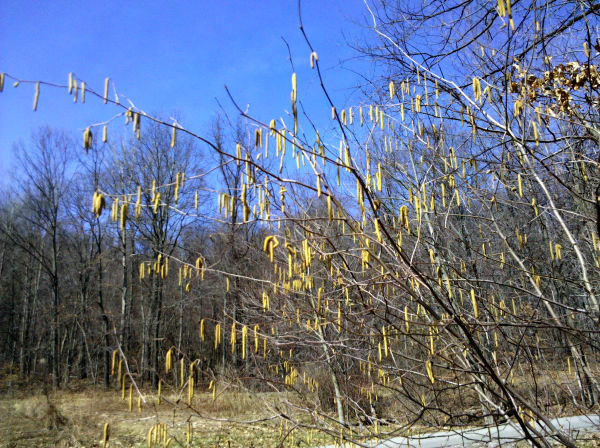
And now for something completely different (not about peregrines).
I found this understory tree “blooming” in many places along the North Shore bike trail at Moraine State Park on Sunday. It drew my attention because of its long, yellow catkins.
Do you know what it is? Here are some hints:
- The plant grows in clumps like a shrub.
- The clumps are on average about 10 feet tall.
- Its long yellow catkins indicate it’s in the birch family.
- Many of the catkins sprout alone instead of in bunches.
- The catkins are as long as — or longer — than my fingers.
- The leaf buds are alternate on the branches.
- The bark is smooth and speckled.
Leave a comment with your answer.
(photo by Kate St. John)
I think this is a hazelnut, because I have one that I planted in my yard. I saw some growing along the Butler Freeport bike trail last weekend. I don’t know if it’s native to this area, although I do know that there is an American variety of hazelnut.
I think it’s an American Filbert (hazelnut) since I have been watching mine grow and the catkins are yellow and very, very long…Catkins for Speckled Alder are reddish and I don’t see any little cones and they grow larger than 10 feet. I also noticed 2 sizes of catkins spaced along the stem….and maybe you can answer that is one a male and female catkin or one for next year? This is the most and the longest catkins these plants ever had. I had 2 hazelnuts last year and unusual covering around the nut. (I just took a photo of this too.)
Witch hazel?
The female flowers are tiny and red -situated along the twig. The yellow catkins are this year’s male flowers. They are situated at the tips of the twig and hang down. In winter they turn hard and brown. So what you are seeing is both this year’s male catkins and some of last year’s that are still hanging on.
Does anyone know, do you need two separate hazelnut (filbert) species for pollination? I wouldn’t think so, because I think we only have one or two species that are native to the US, so they must pollinate themselves. But I’ve always read that if you’re buying the European filbert plants, you should buy two different species to get them to pollinate (like with apples, right?). When I bought the hazelnut plant I have (at the native plant nursery in Williamsburg), the proprietor told me that I would not need another plant for fertilization. I only have one, so it would have to self pollinate. I do get nuts, but not a lot, and the squirrels usually get them.
Thanks, everyone, for your answers. Yes, it’s American Hazelnut (Corylus americana). Here’s more information about it:
http://www.fisharama.org/resources/wildlifehabitats/corylusamericana.html
and
http://plants.usda.gov/plantguide/pdf/pg_coam3.pdf
What’s amazing to me is how different each reproductive stage looks from the other: the long yellow male catkins, the little female flowers, the crenellated bracts. An amazing plant.
Thanks Diane for the info about the female flowers. I checked mine and if they all pollinate, I should have quite a few Hazelnuts this year…when I looked earlier, I didn’t see them, so maybe they just came out. They look like red little stars…the wind was blowing and I couldn’t get a photo…